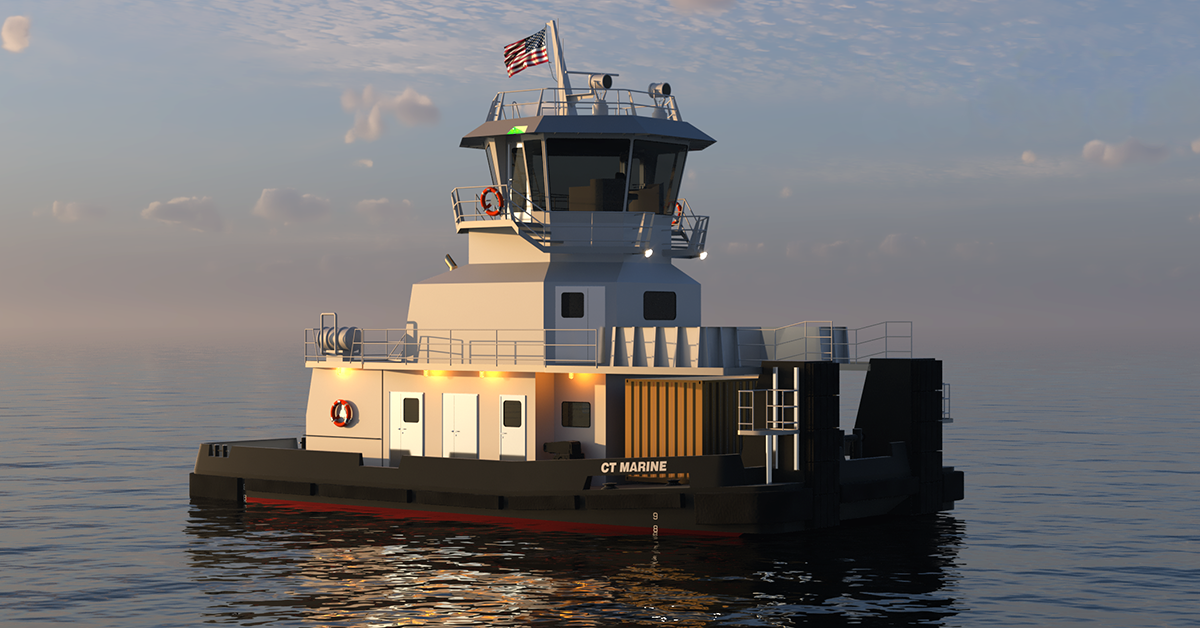With rapid battery swap at crew change and around-the-clock monitoring, CT Marine’s new all-electric vessel is designed to provide harbor service while also reducing fuel and crew costs.
CT Marine debuted the details and concept art for the vessel, the equivalent of a 1,500 hp. boat, at the Inland Marine Expo, held May 28–30 in Nashville, Tenn.
Christian Townsend, CT Marine’s owner and CEO, said that, while the company has studied the idea of adding alternative fuels to a vessel for decades, the concept for the all-electric vessel came about five years ago. David Sehrt, the now retired chief engineering officer of Ingram Barge Company, asked him to co-write a report with Ingram and Vanderbilt University for an American Waterways Operators meeting in Pittsburgh, Pa.
The small, five-page design presented at AWO got Townsend thinking. He never liked the idea of having batteries down inside a boat because of the possibility of fire and thermal runaway, so what if they were placed somewhere else?
“We wanted to have the batteries outside of the living space and not underneath it, so the only place we could put it is forward of the house,” he said.
With this idea, a partnership took place with Brent Perry and his team, pioneers of marine energy storage known for founding Corvus Energy and SHIFT Clean Energy. They now lead NetZero USA. They introduced Townsend to the concept of battery swapping and demonstrated how it could be applied effectively to harbor vessels.
Ideally, it would be best to have batteries located where they could be moved on and off the boat, swapped out for recharging at the end of each shift, Townsend thought. That vision aligned with the work Perry and his team at NetZero were pursuing. In 2024, NetZero engineered a solution to package the energy required for a working harbor boat into a single, 20-foot container. The container can be swapped in about 25 minutes, quick enough to fit within a crew change. It also delivers the power needed for a full, 12-hour shift.
Together, the containerized batteries, the swap-and-change infrastructure and the vessel design make all-electric harbor operations practical, Townsend said.
“For the first time, operators can match diesel performance with a cleaner, safer and more cost-effective alternative built for continuous service,” he said.
Short Delivery Time
Townsend expects the first of the 70-foot by 33-foot boats, each with an 8-foot draft, to go into service in the Houston Ship Channel in as little as 18 months. Build time is short, with almost all components sourced and assembled in the United States, he said. Townsend expects to have at least a half dozen of the fleeting boats in the region within the first few years.
The battery containers will be leased by the kilowatt-hour, giving operators the benefit of an energy source without ownership costs. Fuel savings are projected at 5 to 12 percent, depending on fuel prices, while Townsend estimates the cost to be about 14 percent lower than a comparable conventional build. Townsend also expects maintenance costs to be reduced by about 65 percent “because we have so much less equipment running with an electric system over a diesel system.”
Safety-First Concept
The first thing companies want to know about battery-powered vessels is how safe they are.
“One big advantage of our system is that our batteries are water-cooled,” Townsend said. “They’re not air-cooled, which is what most people are using. They are safer, and they will run longer.”
With all the batteries enclosed in a specially designed container built to rugged standards, air and water circulation and fire protection are all enhanced, he said.
While customers will order the vessel to be built at a shipyard, NetZero will build and install a specially designed control room, designed to blend into the boat, at the rear of each vessel, ensuring proper installation and maintenance.
“Everything’s been built to basically hospital cleanliness, and it’s been tested and painted,” Townsend said. “NetZero delivers a totally integrated system that can be assembled and delivered to the shipyard.”
“The goal was to take the responsibility for the electrification of the vessel away from everything else,” he added. “The NetZero team will deliver the turnkey systems, with a full support staff for the propulsion system and the battery, partnering with our customers to certify their staff in service and support as well.”
Each boat’s system will be remotely monitored 24 hours a day, with that information shared with the operators so that everyone can use real-time data to optimize vessel performance and operations, Townsend said.
Redundancy is key, he said, noting if there is a problem in the control room, a whole new control room can be dropped in.
“We are simplifying the operation of the vessel to reduce costs and need for crew on the vessels,” he said. “It is a partnership approach to vessels and vessel operations that will help each operator improve its business.”
‘Pit Bull Tough’
“For the last five years we’ve been discussing with fleeting companies, what’s the ultimate boat?” he said.
Feedback from those conversations helped CT Marine develop a heavily bult boat with a low center of gravity that is purpose built for fleeting.
“It’s like the body of a pit bull,” Townsend said. “It’s low and strong and incredibly nimble with CT Marine’s TwinDIFF Steering.”
The vessel is offered in open-wheel, CT28-sl nozzle or L-Drive.
CT Marine is known on the inland waterways as being the company that has designed every towboat on the Mississippi River more powerful than 6,600 hp. since 1988. With the guidance of Perry, whose work in electrification has already transformed ferries, tugs and offshore support vessels, Townsend sees pushboats as the ideal next step and the future of this class of vessel.
Summing up, he concluded, “I think it’s the most significant boat we’ve ever done.”
Featured image caption: An artist’s rendering of CT Marine’s all-electric harbor vessel. (Courtesy of CT Marine)




